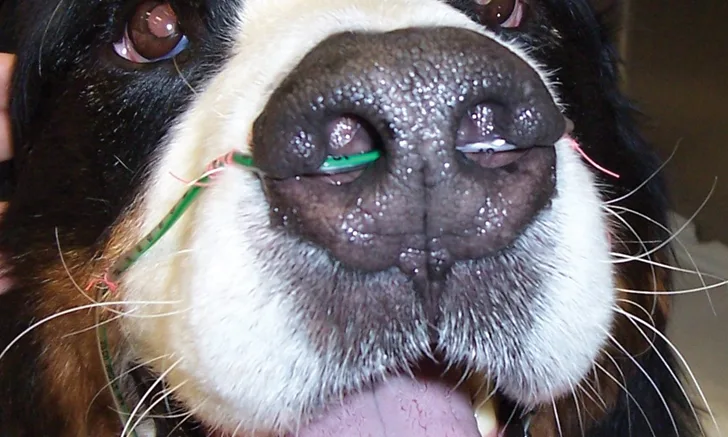Novel Canine Oxygen Therapy Techniques
Rebecca A. Johnson, DVM, PhD, DACVAA, University of Wisconsin

FIGURE Bilateral nasal catheter in a Bernese mountain dog. Catheters are directed medially through the ventral meatus and secured to the skin for oxygen administration. For high-flow nasal cannulas, double-prong cannulas should be approximately 50% the diameter of the nares to allow high-flow administration with minimal airway pressure increases.
In the Literature
Daly JL, Guenther CL, Haggerty JM, Keir I. Evaluation of oxygen administration with a high-flow nasal cannula to clinically normal dogs. Am J Vet Res. 2017; 78(5):625-630.
The Research …
Acute respiratory distress is frequently treated with conventional oxygen-delivery systems (eg, face masks, hoods, oxygen cages, unilateral or bilateral nasal cannulas or catheters; Figure) using nonheated, 100%-inspired oxygen. However, patient intolerance, patient complications (eg, barotrauma, pneumonia, pneumothorax), and low or variable alveolar oxygen levels can cause difficulties, and if more invasive oxygen-delivery techniques (eg, continuous positive airway pressure, mechanical ventilation) are required, cost, equipment, need for sedation, and personnel required must be considered. Thus, a clinically useful, noninvasive method to improve alveolar, and subsequently arterial, oxygen levels is desirable.
This study evaluated the use of a commercially available high-flow nasal cannula (HFNC; double-prong, ≈50% of nares diameter) to deliver heated, humidified oxygen at high flow rates. HFNCs use improved dead-space washout to increase consistency and concentration of alveolar oxygen, subsequently increasing arterial oxygenation with minimal alterations in transpulmonary pressures and gastric distension. Three techniques (ie, conventional oxygen therapy at 100 mL/kg/min, HFNC at 20 L/min, HFNC at 30 L/min) were administered randomly to 6 sedated dogs. All oxygen delivery methods improved arterial partial pressure of oxygen (PaO2) from baseline (median PaO2, 85.9 mm Hg); however, PaO2 values with HFNC at 20 L/min and 30 L/min were significantly higher (median PaO2, 519.9 mm Hg and 538.1 mm Hg, respectively) than with conventional nasal oxygen flows (median PaO2, 202.9 mm Hg). Transpulmonary pressures did not differ from baseline and among treatments, and although radiographic evidence of gastric distension was observed in one dog, it was not apparent clinically.
This study presented a novel method of oxygen supplementation that provides advantages such as improved delivery of humidified and warmed oxygen to alveoli with minimal side effects in normal dogs. Other studies are beginning to investigate the efficacy of such methods in compromised patients such as those with intrinsic pulmonary disease or ventilation disorders.1 Further studies regarding any associated histopathology are needed.
… The Takeaways
Key pearls to put into practice:
With conventional supplemental oxygen administration, alveolar oxygen levels are often low or variable despite 100% oxygen delivery.
Commercially available HFNC systems (flow, 20-30 L/min) may offer advantages (eg, improved PaO2) over conventional oxygen-delivery techniques using nasal cannulas (100 mL/kg/min).
Although significant complications associated with HFNCs appeared minimal in normal dogs in this study, further studies regarding complications associated with such high flows are needed.